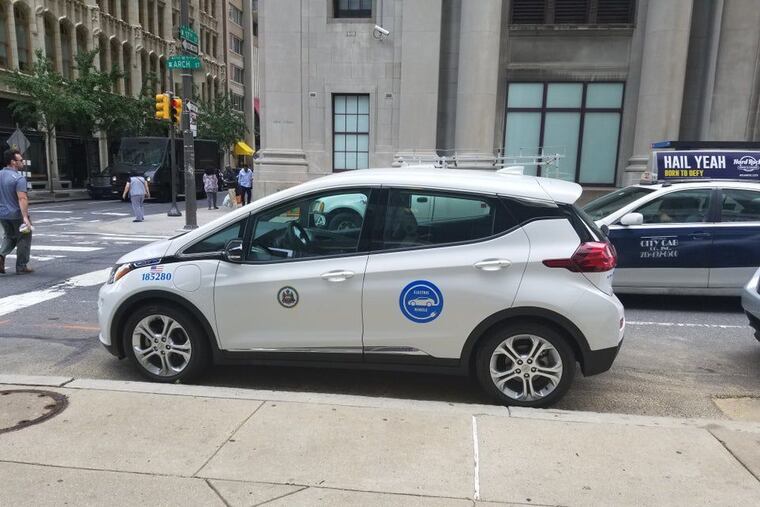Philly plans to make its 5,500 vehicle fleet all electric after 2030
Philadelphia will stop buying gas-powered vehicles for its 5,500-strong fleet by 2030.

Philadelphia plans to buy more electric vehicles in the coming years and stop buying fossil-fuel-powered vehicles altogether by 2030, with the goal of eventually making its 5,500-strong fleet all electric, according to a recently released plan.
It’s a big task, especially without any large-scale charging infrastructure currently in place, according to the clean fleet plan by the city’s Sustainability and Fleet Management offices. But officials say that, over the long run, a complete transition to electric vehicles will save tons of carbon dioxide from being emitted via the tailpipes of municipal vehicles, as well as being easier to maintain.
This transition will help the city toward achieving its goal of becoming carbon neutral by 2050, the report says.
There is no estimated cost for the transition in the plan, but many of the new electric cars will simply replace planned future purchases of fossil-fuel-powered vehicles. Though electric vehicles tend to be more expensive, the report notes that a current federal tax credit provides up to $7,500 off the purchase of a new electric vehicle.
The municipal fleet includes vehicles from 43 city departments, including police, fire, streets, and parks and rec.
“The city’s commitment to transitioning our fleet to clean and electric cars provides us with the opportunity to lead by example and demonstrate the environmental benefits as well as operational and fuel efficiency savings an electric fleet provides,” said Christine Knapp, director of the Office of Sustainability.
Knapp said the city has about 50 chargers now, and plans to budget for more charging stations in coming years. She said that there are grants available to help and that the city expects more funding opportunities under the Biden administration’s focus on electric vehicles and renewable energy.
President Joe Biden gave a speech in Scranton on Wednesday touting his Build Back Better bill, saying it contains $7 billion for a national network of electric vehicle charging stations. But the bill faces stiff resistance from Sens. Kyrsten Sinema (D., Ariz.) and Joe Manchin (D., W. Va.) over the size of the package and how to pay for it. Democratic leaders are negotiating with the administration on a scaled-back version, so it’s unclear what parts of the bill will survive.
The city’s plan lays out a strategy for transition, noting potential challenges such as installing enough charging stations, the lack of electric SUVs and trucks on the market, teaching employees about EV refueling, and questions about battery capacity and driving range.
Trucks of various sizes account for almost half of the city’s fleet, followed by SUVs, including those used for police pursuit, at 20%. Sedans, the easiest vehicle to switch to electric, make up only seven vehicles of the non-police fleet.
Police vehicles present a challenge for the switch since public safety demands particularly high performance and responsiveness, the report states. They also require longer and more erratic duty, posing a concern when transitioning to alternative fuels.
Overall, the fleet accounts for 13% of city government’s carbon output. The police, streets, and water departments are the top three users of fossil fuels, together burning 4.2 million gallons of gas or diesel per year. (SEPTA, a separate entity, is not included in the plan.)
Philadelphia started buying plug-in hybrid vehicles in 2014 and now has a mix of 500 vehicles that are hybrids, plug-in hybrids, compressed natural gas-powered, and fully battery electric.
The current lack of charging capability presents “the most challenging aspects” of the transition, the report notes. Chargers will have to work with a range of vehicles and be placed in easy-to-access locations. It will require centralized management of stations, strategic charging hubs, and adding charging requirements for parking spaces the city leases.
With a recommended ratio of two cars per charger, the city would need at least 2,800 stations.
Knapp said, however, chargers are likely to become faster and more affordable in the coming years, possibly needing only 15 minutes to fully charge. That could reduce the need.
Regardless, Philadelphia officials believe they can purchase at least 1,600 light- and medium-duty electric vehicles by 2030, which would eliminate 11,000 metric tons of carbon dioxide tailpipe emissions annually. All purchases after 2030 would be of electric vehicles, and eventually replace the entire fleet.
The report estimates that an electric vehicle reduces carbon dioxide emissions by 70% on a per mile basis (carbon dioxide is still emitted through the electric power grid used to charge the cars).
Philadelphia hopes to buy 100% of its energy for city operations from renewable energy by 2030, which would reduce those emissions effectively to zero. As a result, officials believe they can have the city’s entire fleet fossil-fuel free by 2050, with both zero tailpipe emissions and zero carbon emissions from the grid.